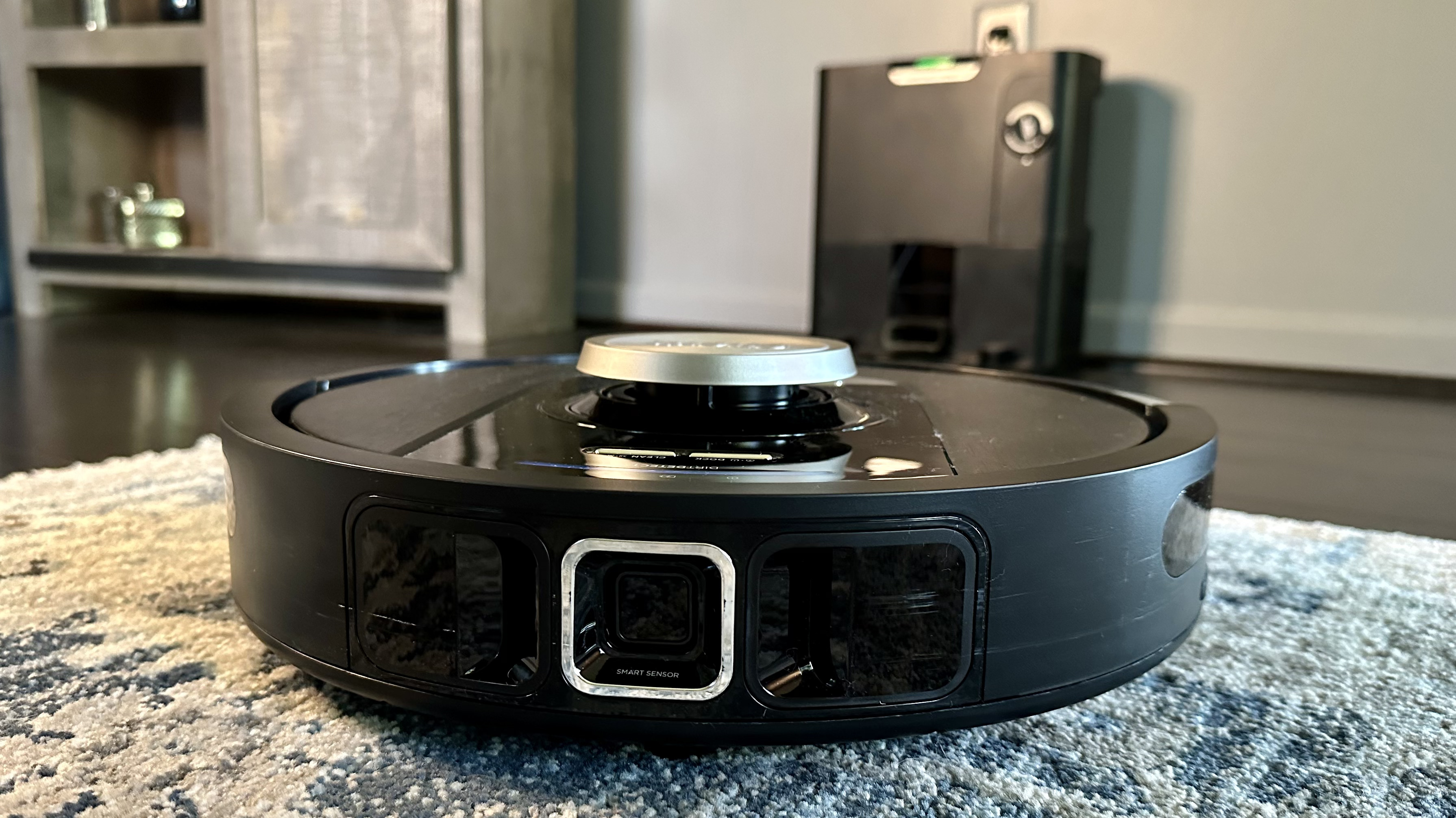
The Shark Detect Pro Self-Empty Robot Vacuum is the latest robot vacuum from the SharkNinja brand. This device is supposed to make cleaning your home easier, offering a robot vacuum packing technology ready to detect dirt, clean corners, and never get stuck. Then, it will empty its dust box in the bagless, self-empty base after finishing a task. All these features should put the Shark Detect Pro up there with the best robot vacuums, but only if it delivers. And in this case, things aren’t as great as they appear.
I tested the Shark Detect Pro’s features by throwing sprinkles, oats, and flour on both hard and carpeted floors, seeing how it faired while picking up the debris. For the most part, almost everything was gone using even the lowest power level. The dirt detection technology appeared to boost suction when going over the more concentrated mess. But it didn’t finish cleaning up the mess, leaving about half of the debris, which it returned to later without increasing the suction.
Beyond more rigorous tests, I sent the robot vacuum out to do typical home cleanings, observing how it navigated and handled more common messes. When navigating, the vacuum recognized stairs, stopping itself from falling. But when it came to other obstacles, it would either keep a large space around them or run into them with no rhyme of reason. As for the “special” edge technology that supposedly helps the vacuums clean corners and edges, it seemed to serve no purpose, as all the crumbs under the lip of my kitchen cabinets were still there after every vacuuming.
During and after cleanings, the Shark Detect Pro would return to the self-emptying base to empty the contents of the dust box. Occasionally, debris would fall from the dust box on the way to the base, and the base doesn’t always remove all the dust box’s contents. Still, the base itself is sleek and compact, letting it blend well in most spaces, though it does have a gimmicky air freshener feature. However, the best part of the base is that it’s bagless, meaning you won’t ever need to worry about buying a replacement bag.
The most underwhelming feature of the Shark Detect Pro isn’t the actual robot vacuum but the lackluster companion app it’s paired with. It’s hard to navigate with few features, while intelligent mapping is severely lacking.
Admittedly, the Shark Detect Pro has flaws. But when it comes to actual vacuuming performance, it delivers. You’ll love all the extra free time this device brings by eliminating one household chore.
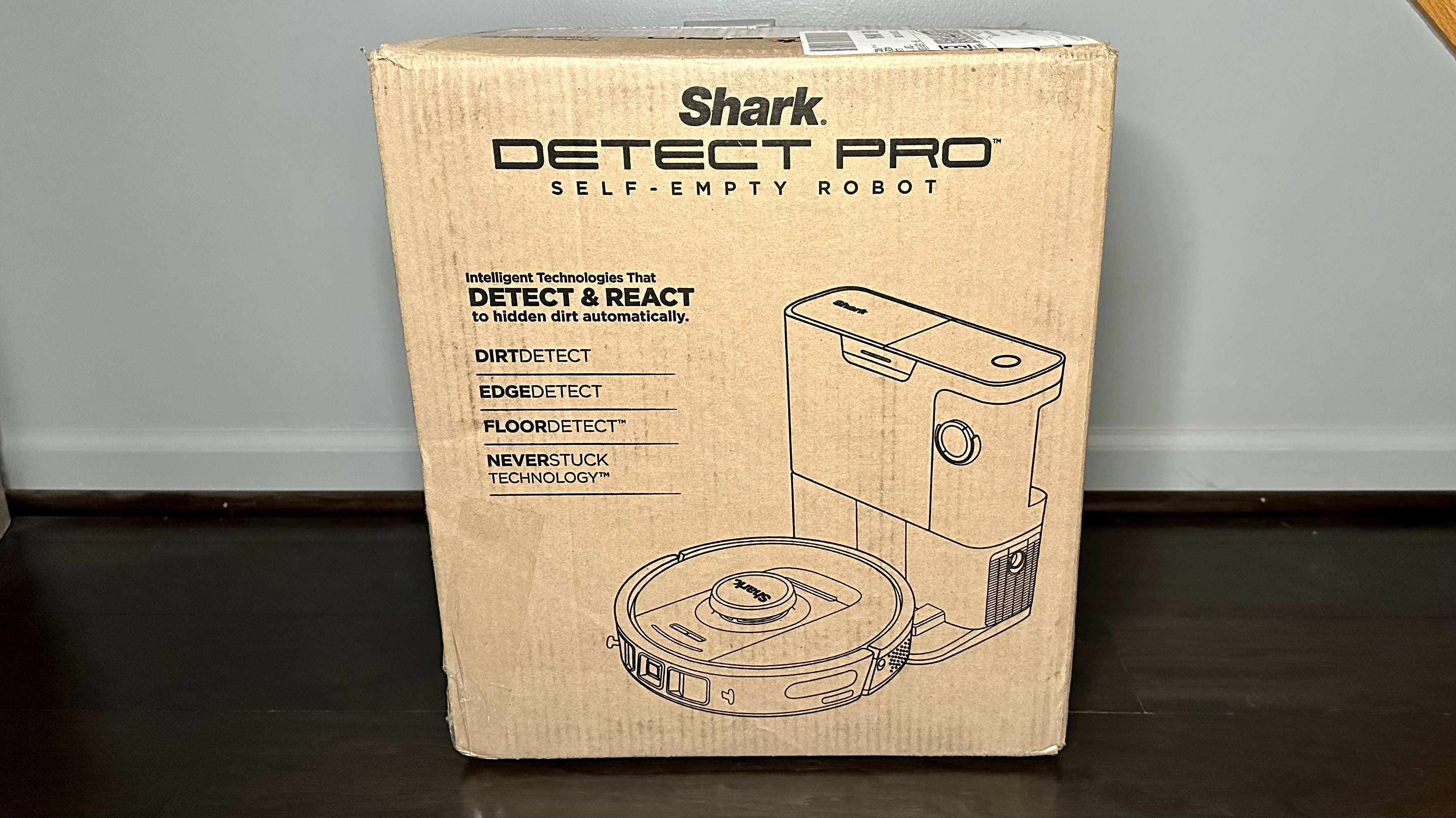
Shark Detect Pro: First impressions
The Shark Detect Pro arrived in a much smaller package than I expected, making it easy for one person to maneuver. Upon opening the box, I was greeted with a quick start guide and an instruction booklet. Beyond that, the vacuum’s components were placed inside well-labeled cardboard boxes. The robot and the self-emptying base were wrapped in plastic for protection, but that made the packaging less eco-friendly than it could’ve been.
Setting up this robot vacuum was on par with others I have tested. It was simple and painless, and almost everything was ready to go straight out of the box. All I had to do was snap the side brush onto the robot and install the odor dial on the self-emptying base. From there, I plugged in the base, plopped the vacuum on it to charge, and it immediately emptied into the base, which took me a little off guard.
The whole setup looked sleek and slim compared to many other robot vacuums I’ve used, thanks to the self-emptying base’s smaller dimensions and the black coloring throughout. Though, I was also a little skeptical as to how it would perform because of its compact size.
To send the device out on the first run, you need to download the Shark Clean app, create an account, and register the robot. Again, it was an easy process. You just need to add your basic info. There’s even a fun name generator to name your robot, so I went with “Tony Shark.” From there, Tony Shark easily connected to my Wi-Fi and was ready to go out and map my space.
I decided to let Tony Shark charge to 100% before sending it out on its first initial mapping. But sending it out was as simple as pressing a button on the app. The robot doesn’t actually vacuum during this phase.
As Tony Shark traversed the lower level of my parent’s house, I watched how he handled the terrain of rugs, tile, hardwood, and laminate. I picked up some cables, dog toys, and other obstacles that could interfere with the mapping beforehand. The robot encountered no issues and never got stuck while going about the various rooms. It even managed to avoid falling down the steps to the sunken family room, which was one of my worries.
After about 15 minutes, a fairly accurate map of the space was created using 360° LiDAR vision technology. However, the app failed to differentiate between rooms, making it difficult to understand. In fact, the app was really lacking in many ways—more on that later. Still, the robot vacuum itself performed better than expected in its first outing, but I put it through more rigorous testing to see if it would continue to shine.
Shark Detect Pro: key specifications
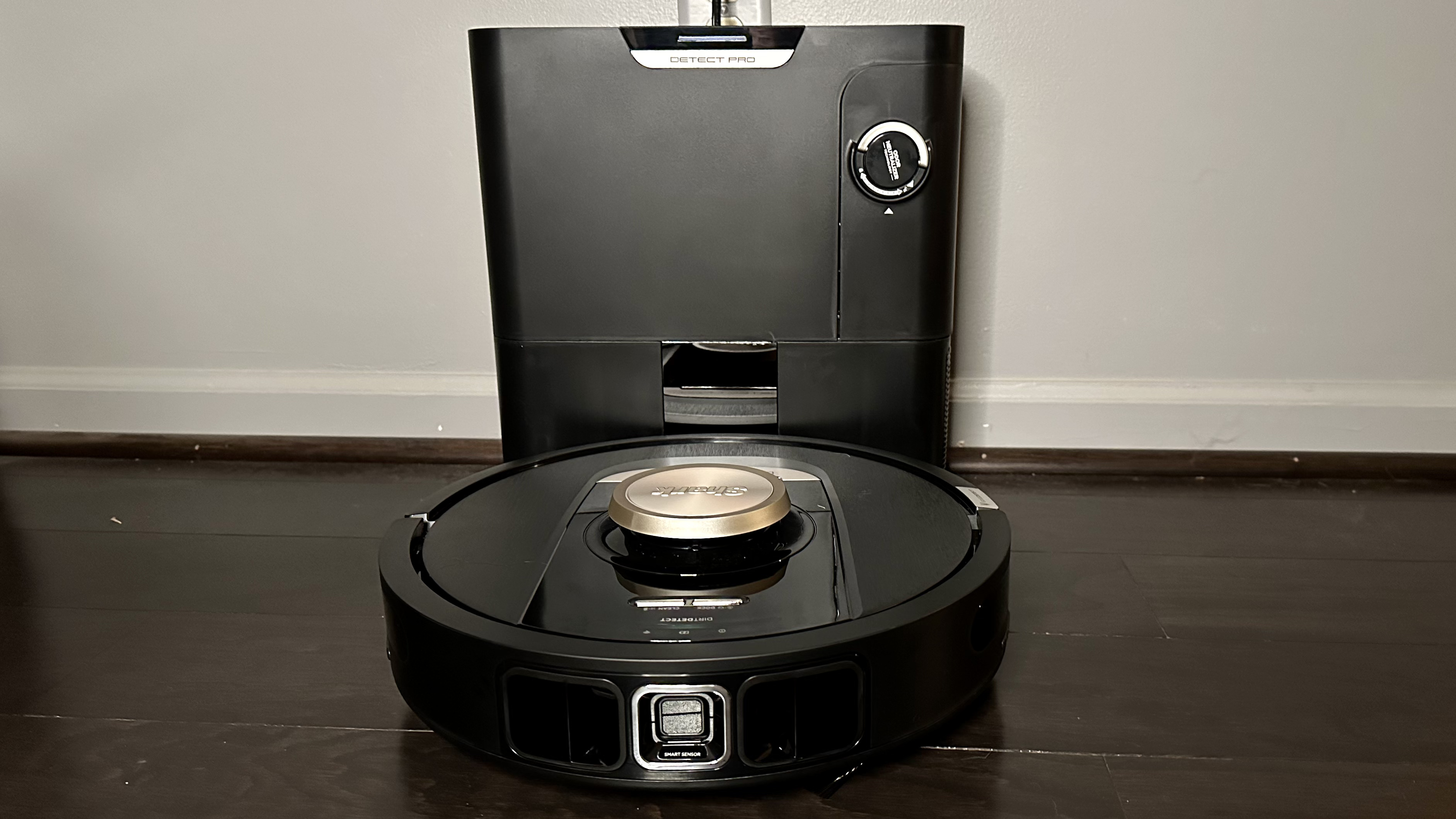
Shark Detect Pro: Price & availability
The Shark Detect Pro Self-Empty Robot Vacuum’s list price is $599.99, and it is available directly from the manufacturer’s website or retailers, including Target and Best Buy.
Some may consider the $599.99 price tag a little high, but it is on par or slightly more than robot vacuums offering similar functionality. If you’re looking for something similar from Shark, but at a lower cost, Shark AI Ultra Robot Vacuum is an older model with almost all the same features, including the bag-less self-emptying base that’s often on sale for $200 less than the Detect Pro.
Score: 4/5
Shark Detect Pro: Design
As I pointed out earlier, the Shark Detect Pro’s setup is more compact than other robot vacuums I’ve tested, with the self-emptying base measuring just 14 x 13 x 8 inches. That makes it ideal for those living in smaller spaces, as it’s much easier to tuck away in the corner of a room. Even if you end up leaving the device out in the open, it’s well-built, appearing to be made of durable plastic material while offering a sleek, svelte design with shiny and matte black finishes on both the robot and base, allowing it to blend well in almost any space. However, that black does tend to attract dust.
The self-emptying base has a few unique features that set it apart from other bases, the first being the bag-less dust bin. In my opinion, it’s a huge plus, as you won’t need to worry about spending money down the line on dust bag replacements. Shark claims it’ll hold 60 days of dust and dirt, but I had to empty it several times during my few weeks of testing. Luckily, emptying is easy. You just press a small gray button on top of the base, and it pops out to be emptied. It’ll click right back into place after.
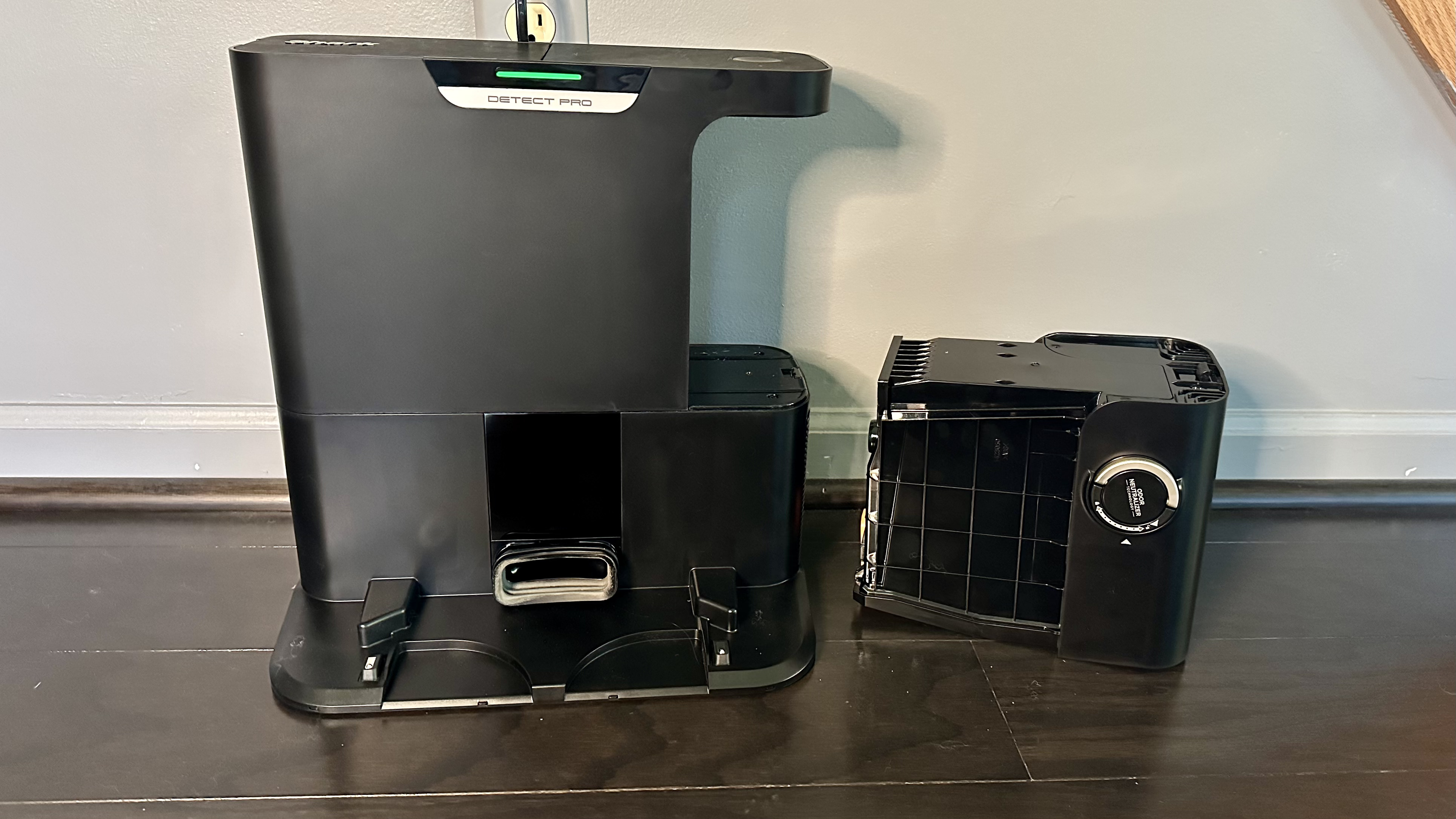
The bagless dust bin may be a boon, but the Odor Neutralizer technology on the base is nothing more than a gimmick. It’s a little air freshener-type contraption that lets you dial in the intensity of its scent to help with odors in the dust bin. The only problem is that a smelly dust bin has literally never been a problem for me. Sure, the air freshener smells good, but only if you’re a couple of inches from the base. It’s a completely unnecessary addition, and the money used to add this technology could’ve been better spent improving other aspects of the robot vacuum.
The self-emptying base allows the robot vacuum to easily slot into it to empty its dust box and charge. It’ll do this after every cleaning, and you can set it to go back to the base station every 30 minutes during cleaning to empty the dust box. I found the 0.24-quart dust box on the side of the robot to be plenty big for my whole home cleanings, and you can always pop that dust box out and empty it yourself if you don’t want it to empty at the base.
Of course, the robot vacuum matches the base’s aesthetic and is an average size, at 13 x 13 x 3.3 inches. On top, you’ll find a large LIDAR sensor and two buttons: dock and clean. The dock button will send the vacuum home or power it on and off. The clean button pauses or resumes your current cleaning or does a “Matrix” spot clean of a five-foot by five-foot area. There’s even a cool LED indicator light that glows different colors, telling you the battery’s status, when it’s in “DirtDetect” mode and more.
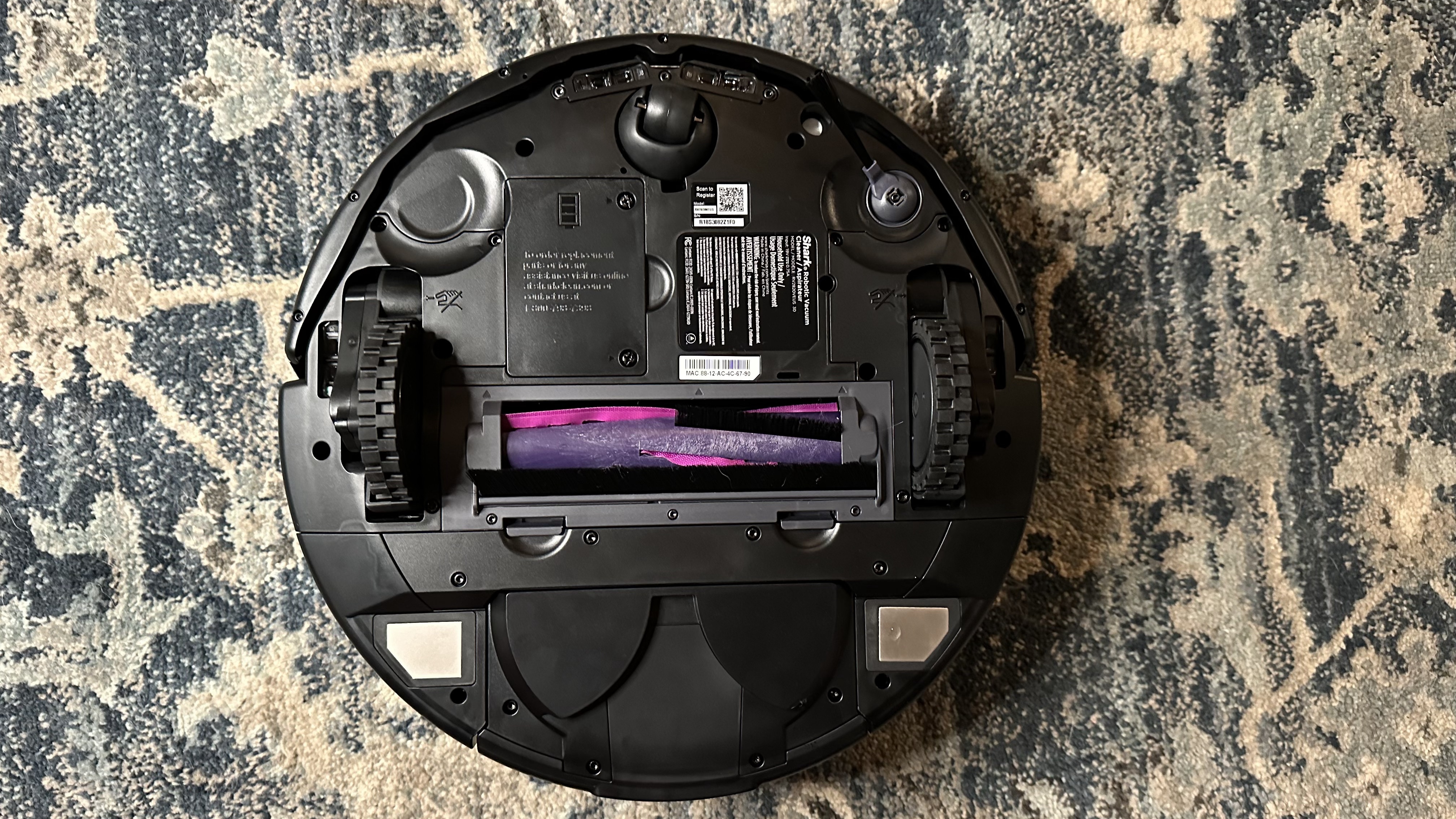
On the underside of the device, you’ll find one side brush and the main brush. Both are easy to remove if you get hair, strings, or other debris stuck in them. There’s also one castor wheel as well as two driving wheels that offer NeverStuck Technology, allowing it to go up and over obstacles.
Score: 4.5/5
Shark Detect Pro: Performance
When it came time to test the Shark Detect Pro, a.k.a Tony Shark, I observed the entire setup’s performance during typical vacuuming tasks, did more rigorous testing of the vacuum’s settings on both hard and carpeted floors, and compared the Shark Clean app to other robot vacuum apps I’ve used.
For my first test, I spread sprinkles across the hard laminate kitchen floor and sent Tony Shark out on its normal power level. As it went about the floor cleaning up the sprinkles, I noticed that the vacuum had no rhyme or reason in how it cleans. I was expecting some sort of pattern, but there wasn’t one. It was overly cautious around the edges of the kitchen cabinets, too, leaving tons of crumbs behind and leaving me questioning what the “EdgeDetect” technology Shark advertises actually does. The side brush on the vacuum also moved extremely slowly, so I’m not sure it did anything to assist in the cleaning.
When it came to picking up the sprinkles, I was pleasantly surprised. Tony Shark managed to clean up the majority with a special “DirtDetect” mode automatically activated around the mess, which increased the suction level. An LED on top of the machine glowed purple to indicate the “DirtDetect” mode was on.
I ended up testing the robot vacuum using all the different power levels available, and it continued to perform similarly. I also checked the noise level of each power setting at this time. In eco mode, it averaged about 55 dB. It was slightly louder in normal mode, hitting 62 dB, and 65 dB was the average in max mode. The noise was similar to or slightly louder than a window air conditioner; not too distracting, though you might not want it running at night.
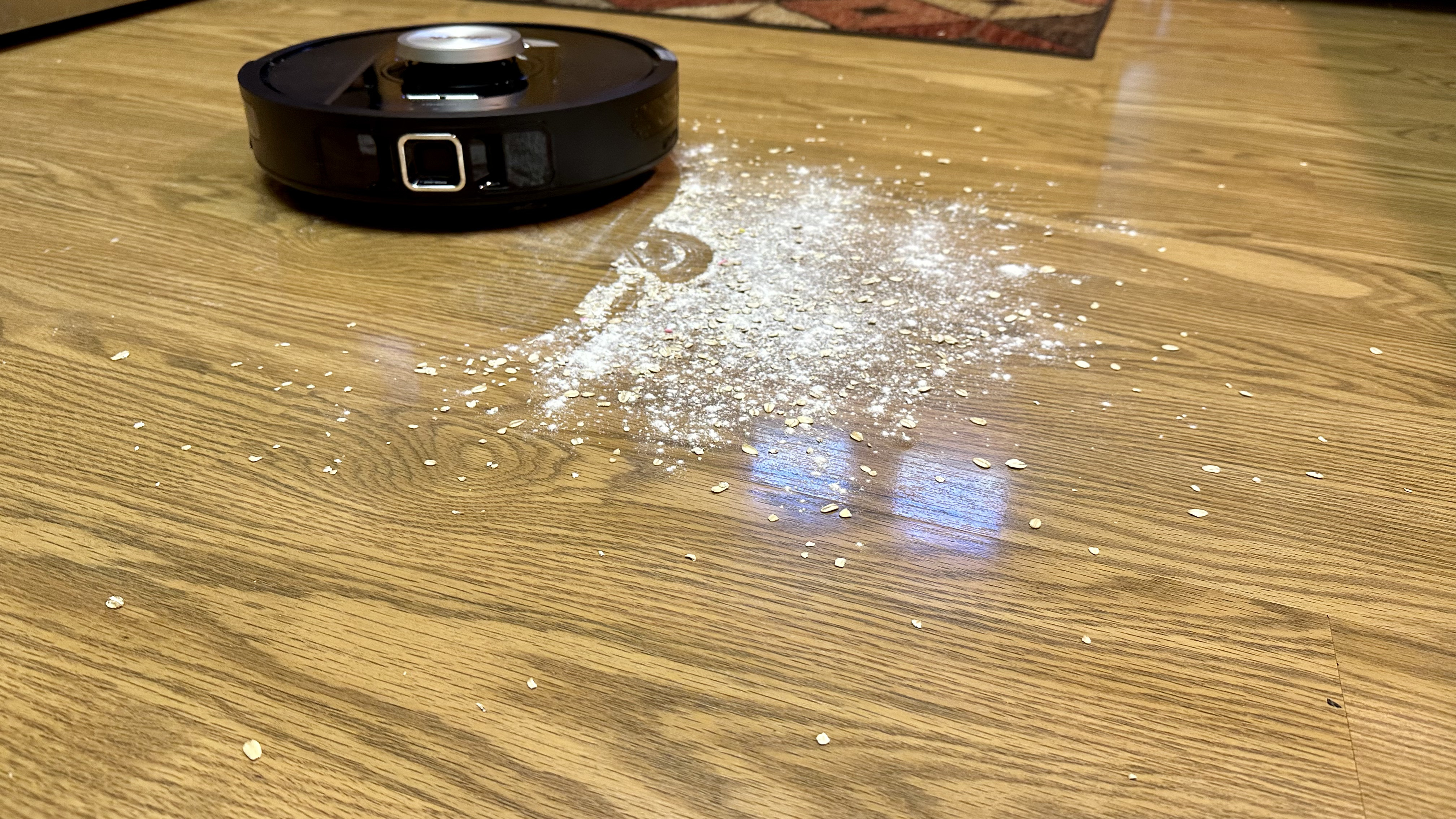
The same test was done using flour and oats at different vacuum power levels on the same laminate floor in the kitchen, but the results weren’t as great as the sprinkles. It did leave some of the mess behind, no matter the power setting. I also noticed that the “DirtDetect” mode activated when cleaning about half the mess, but then it moved away, leaving the other half behind. It eventually came back to clean up the rest of the flour and oats, though the “DirtDetect” mode didn’t activate.
After finishing the job, Tony Shark returned to the base station to empty its dust box. However, on the way back, some oats and sprinkles fell out while going over thresholds and other bumps. Upon arriving, the base station emptied the dust box, hitting a noisy 75 dB, which could startle you if you’re not prepared.
When I lifted the vacuum up to see if the dust box’s contents had emptied, a good amount fell right out of the main brush compartment, spilling onto the floor, and making a big mess. I sent the Tony Shark out to pick up the spill, but it failed to suction everything up, leaving me to use a broom to complete the job. So, don’t count on the self-empty base to consistently remove all the debris from the dust box
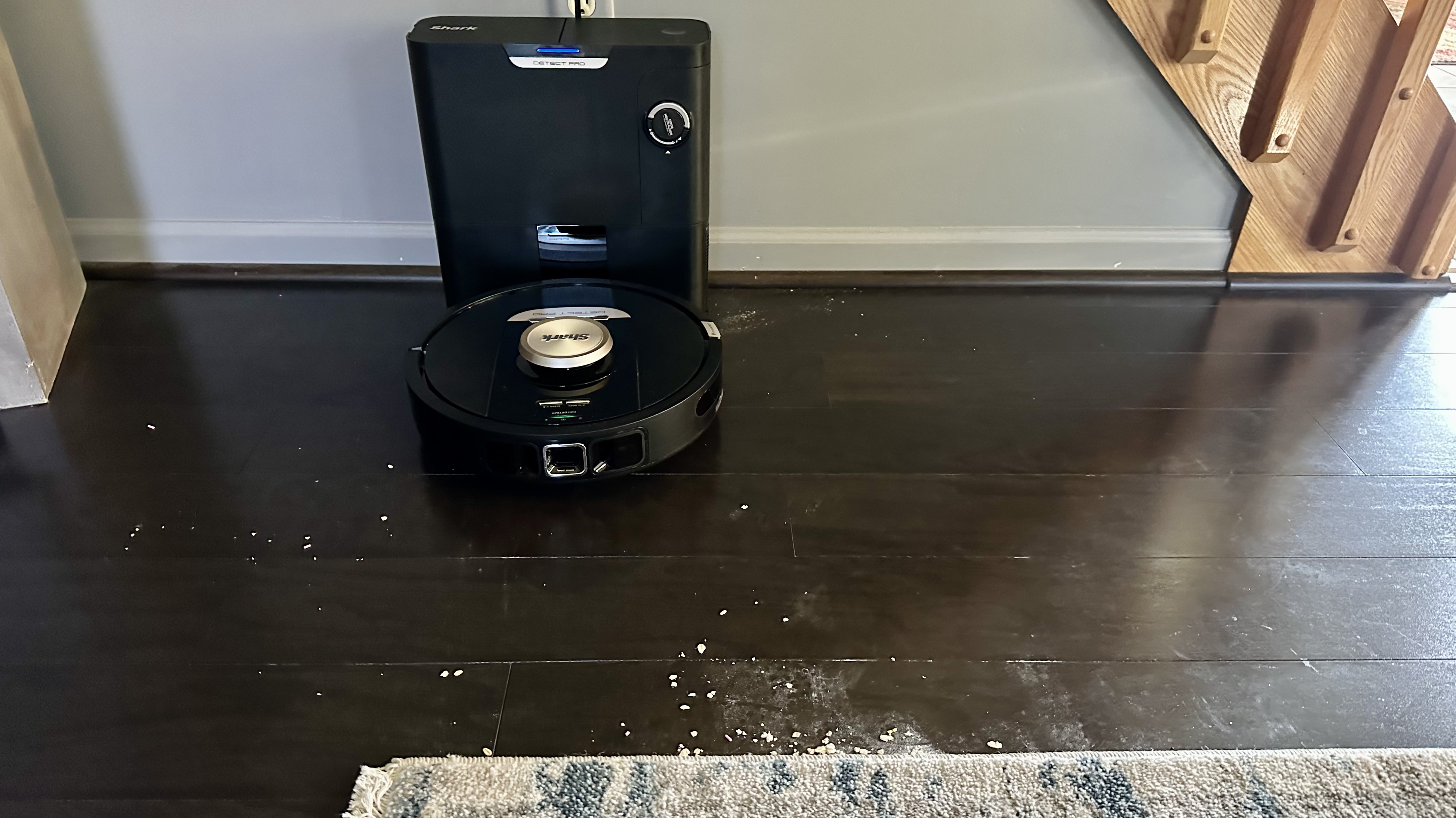
While the Shark Detect Pro performed fairly well on the laminate floor, I also wanted to test it on carpeting. That’s when I noticed a major problem with the Shark app: you can’t save multiple maps. So, I’d have to delete my entire lower-level map to create a map of the upper level of my parent's home where there is carpeting. That’s a huge disappointment, so I just relied on the clean button on the vacuum and pretty much blindly send it out, hoping that would work.
I was still able to successfully test Tony Shark’s performance on carpeting, and it actually picked up the sprinkles, flour, and oats better than on the hard floors, no matter the power setting. However, it did leave some flour and oats behind. The robot vacuum seemed to traverse the carpeted flooring with ease, though it would occasionally lift itself like there was an obstacle when there was absolutely nothing in its path.
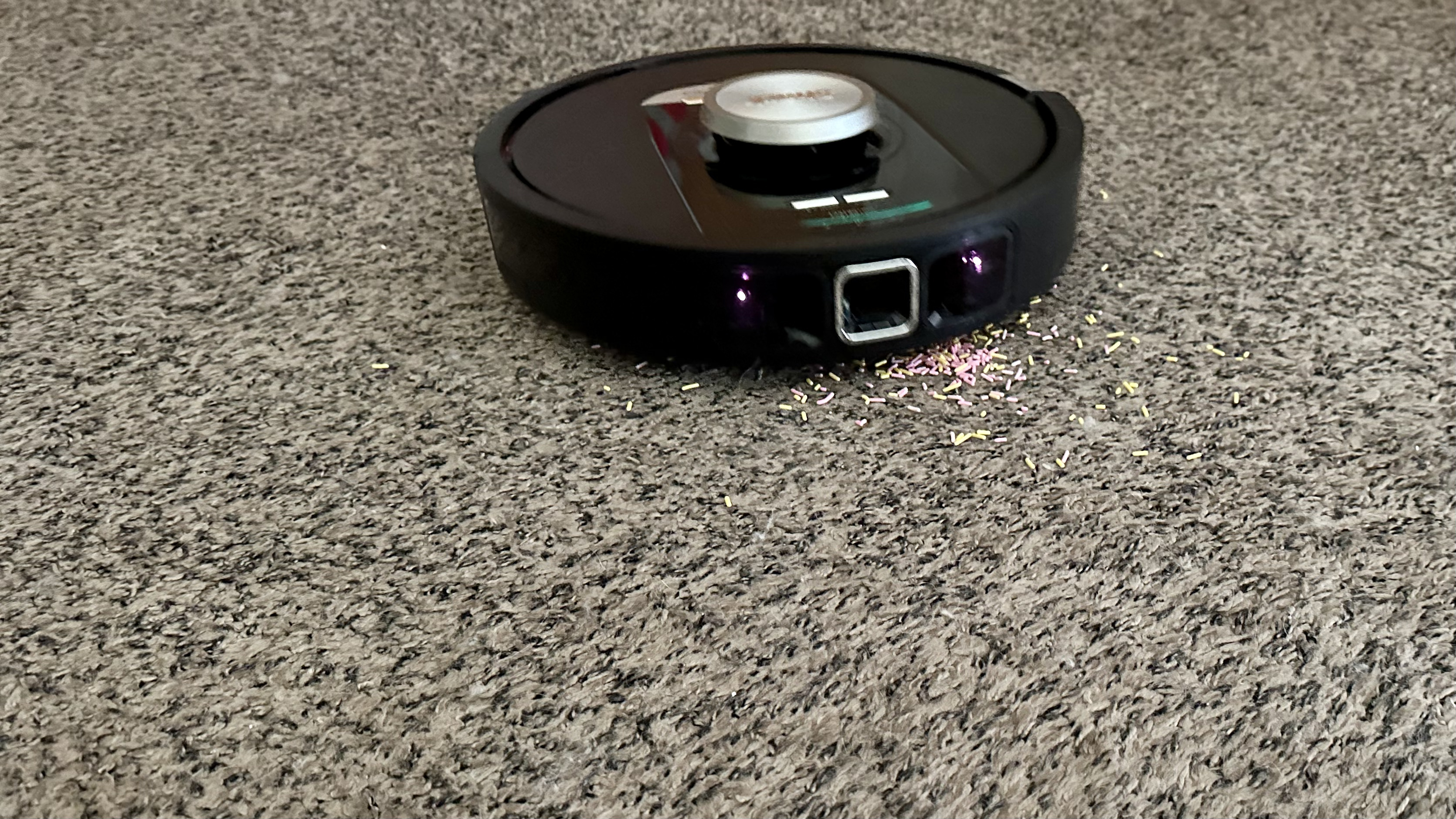
Beyond my more rigorous tests, I sent the Shark Detect Pro out several times per week on the lower level of my parent’s home during my three-week testing period to see how well it vacuumed your typical debris. My parents have a super furry dog who tracks tons of dirt and grass into the house, so Tony Shark had a lot to clean up. It did a great job picking up all the fur on hard floors, but a good amount of finer hair was left behind on the rugs. Unlike many robot vacuums, it does not automatically boost suction on rugs and carpeting, another big disappointment.
For the most part, the grass, dirt, and other debris on the floors and rugs were vacuumed up, but never all of it. Still, they were always significantly cleaner than before I started vacuuming.
Navigation is a big selling point of the Shark Detect Pro, so it’s loaded with several sensors and advertises its “NeverStuck” and “EdgeDetect” technology. I mentioned that “EdgeDetect” was underwhelming, but its NeverStuck feature was slightly better.
Tony Shark went around most furniture with ease but would slightly nudge or leave a big space around certain obstacles to avoid them. The vacuum appeared to do whatever it felt like at the moment, with no reasoning behind it. For example, I put my dog’s plush toy in its path, and it left at least six inches of space around the toy to avoid touching it. Then, when I stood in Tony Shark’s path, it ran right over my feet on several occasions. When the robot got stuck on a dog toy or rug, it could usually free itself. However, at one point, it managed to wedge itself onto a ball and got caught on a quarter-inch thick grate, claiming it was a “cliff,” so it definitely wasn’t flawless.
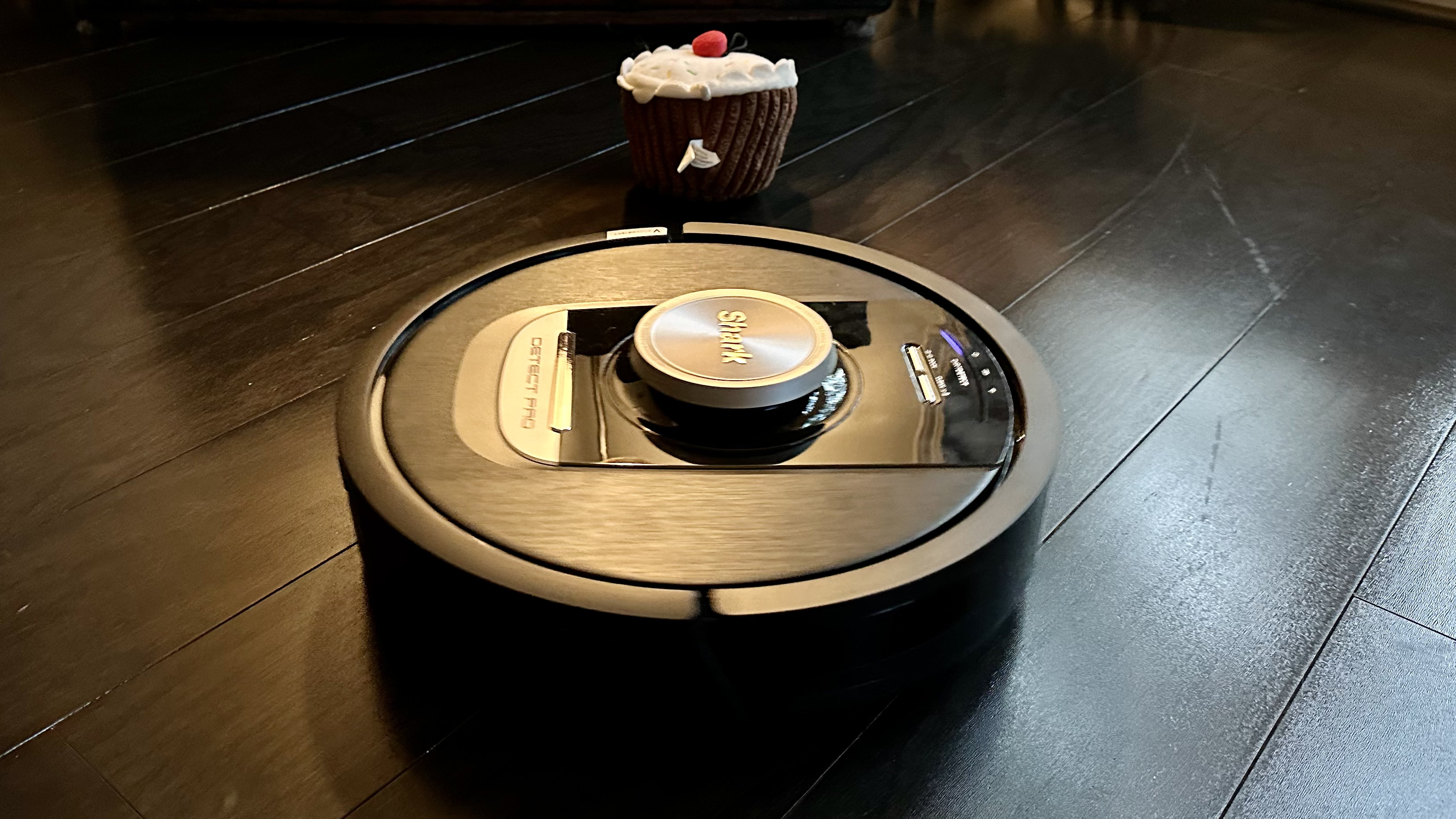
A great battery life is essential in robot vacuums, as you want them to be able to finish a task before needing to recharge. The Shark Detect Pro’s battery was satisfactory, lasting about two hours on its normal power level settings before needing to go back and charge at the base when the battery dropped below 15%. That was plenty of time for it to clean the entire lower level of my house. It took Tony Shark about four hours to recharge back to 100%. You can also set the robot to go back out to complete an unfinished cleaning task after the battery has been charged enough.
The most disappointing feature of the Shark Detect Pro isn’t the actual vacuum or base, but the Shark Clean companion app used to operate it. I found the app confusing to navigate and lacking features. I already mentioned that you can’t create multiple maps for multilevel homes. Even the single map you do get is lackluster. It’s hard to differentiate between rooms when the map is first generated, and when you create they’re not color-coded, the no-go zones can only be rectangular (rather than a line to mark off stairs or a rug edge), and obstacles aren’t noted on the map. These are all handy features I’ve seen in most other robot vacuum apps I’ve tested.
As for voice control, it is possible to use Amazon Alexa and Google Assistant with Tony Shark, but the Shark Clean app gives you absolutely no instruction on to how to do this. I had to look it up on the Shark website, watch a video, and then use the Amazon Alexa and Google Home apps to connect. This should’ve been much easier than it was.
Luckily, the Shark Clean app does let you set cleaning schedules, adjust the power level of the vacuum’s suction, and select specific rooms or a “spot” to clean. When you opt to clean one specific room or spot clean a five-foot by five-foot area on the map, there’s an option to “Matrix Clean,” which is just a deeper cleaning of the space. I didn’t notice much of a difference when using “Matrix Clean” over a typical clean. Even with these quality-of-life features, the app needs some major improvements in the user experience.
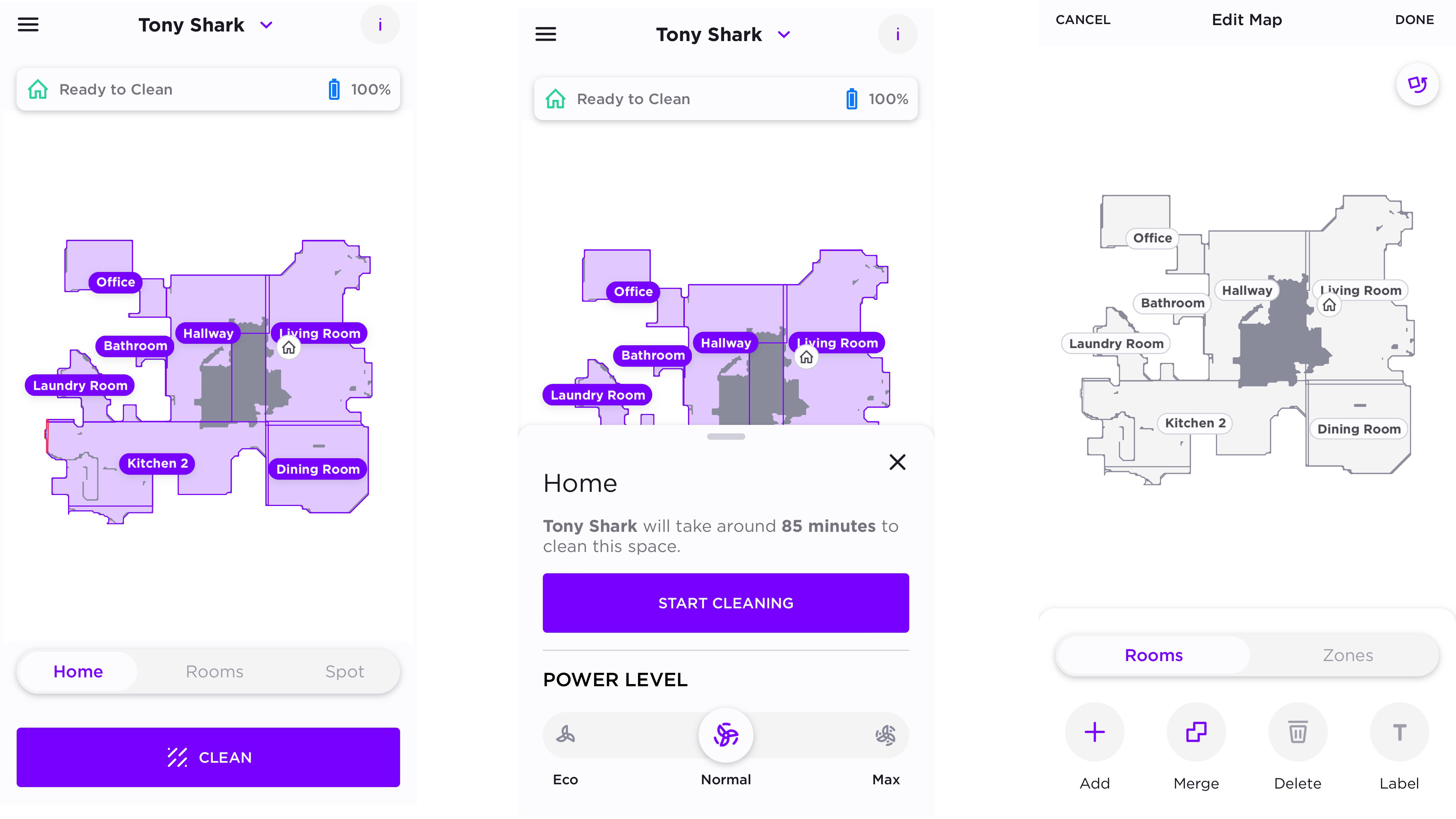
Maintenance-wise, there’s little you need to worry about on the Shark Detect Pro. Shark suggests you occasionally wipe down the robot to ensure the sensors aren’t blocked. You’ll also want to clean off the main brush, side brush, and wheels along with the filters on the dust box and dust bin. All of this is a relatively painless process. Eventually, those brushes will have to be replaced, but that’ll be after over 100 hours of use. The fact that you don’t need to buy bags for the dust bin is a major plus, but of course, you’ll have to empty it once in a while.
Score: 3/5
Shark Detect Pro: How does it compare?
The Shark Detect Pro is a solid robot vacuum, but all it does is vacuum. If you want the ability to mop your floors, then the Yeedi Mop Station Pro is an excellent all-in-one alternative. With it, you get your typical vacuuming performance with a handy feature that increases suction power on rugs and carpeting. Where the vacuum truly shines is mopping. It has two rotating mop pads that can lift up some of the toughest grime, and the base station cleans the mops for you, keeping the process hands-off. Best of all, the Yeedi Mop Station Pro will only set you back $699.99, $100 more than the Shark Detect Pro, and it's often on sale.
As I’ve mentioned several times, the Shark Clean app used with the Shark Detect Pro is severely lacking. One company that gets their app right is Roborock, and their S7 robot vacuum is the perfect, more budget-friendly option to pair it with. With it, you get intelligent multilevel mapping that lets you easily make changes, create no-go zones, and even automatically notes obstacles. The app is easy to use and features-full, so you can make the most of your device. The S7 vacuum features mopping and vacuuming, though you won’t get a self-emptying base like the Shark Detect Pro.
Do you like the sound of the Shark Detect Pro but want something slightly cheaper with similar functionality? The Ultenic T10 Elite might be for you, as you can usually find it for under $400. It offers a self-emptying dust bin and even has mopping functionality. However, the lackluster suction power means it’s probably better for homes with typically lighter cleaning needs.
Should you buy the Shark Detect Pro?
Buy it if...
Don’t Buy It if…
How we tested the Shark Detect Pro
I tested the Shark Detect Pro in my parent's multilevel home for over three weeks. Their home has laminate, hardwood, tile, and carpeted floors with various low-pile rugs scattered throughout. They also have a fluffy dog that leaves lots of hair clumps, dirt, and grass around the house.
I sent the vacuum out to do basic whole-home cleanings several times per week during my few weeks of testing. Before most cleanings, I would usually tidy up the space, picking up dog toys, wires, and other major obstacles that could cause the vacuum to get stuck.
Beyond whole home cleanings, I performed more rigorous tests on the hard floors and carpeting with concentrated debris that included sprinkles, flour, and oats. I also tried the various power level settings on the robot and did a deep dive into the Shark Clean app.
See more about how we test.







